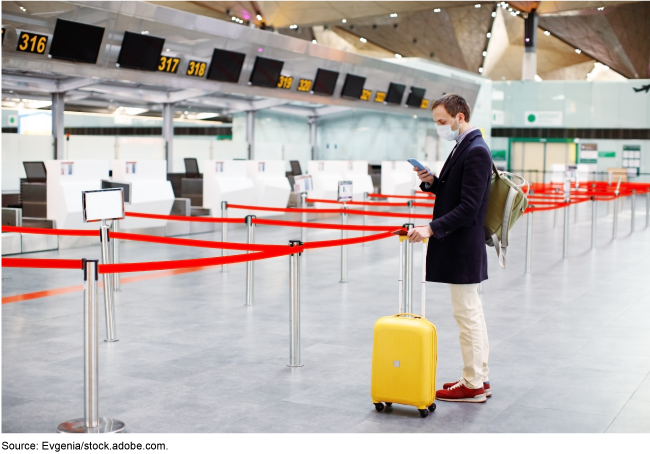COVID-19 Pandemic: Preliminary Observations on Efforts toward and Factors Affecting the Aviation Industry's Recovery
Fast Facts
The COVID-19 pandemic had a profound impact on air travel. Department of Transportation statistics show passenger traffic dropped 60% in 2020, sending ripple effects throughout the U.S. commercial aviation industry.
We testified about the industry's response to the downturn, which included its use of federal help—such as payroll support—and cutting costs.
Given the ongoing uncertainties about the duration of the pandemic and the length of the economic recovery, we also identified principles that could help design any future federal assistance efforts.

Highlights
What GAO Found
Aviation businesses took a range of actions to respond to the dramatic reduction in passenger demand caused by the COVID-19 pandemic. Airlines, airports, and others leveraged federal assistance, such as payroll support and grant funding, provided in two 2020 federal relief laws. In 2020, for example, Treasury awarded $28.2 billion in payroll support assistance for aviation to help airlines and contractors keep employees on their payroll. Industry association and credit rating agency representatives said that federal assistance, in addition to providing direct support, also increased confidence in the aviation industry, which enabled aviation businesses to raise money in private debt and equity markets to strengthen their cash reserves. Some aviation businesses have also reduced labor costs through various means, including through early retirement programs and furloughs. Further, aviation businesses reduced non-labor operating expenditures and certain capital costs. For example, airlines reduced capacity and accelerated the retirement of older aircraft to lower maintenance costs.
The recovery of the aviation industry to pre-pandemic passenger levels depends on factors outside the industry's control—including declines in COVID-19 infections and the recovery of the U.S. and global economies—as well as on industry dynamics in how airlines respond to financial pressures and the changing demand for air travel. Moreover, the effects have been uneven across the commercial aviation industry with certain sectors faring better or worse depending on their business model, customers, and location. For example, according to representatives from an aviation manufacturer, airlines are likely to continue to postpone the delivery and purchases of long-haul aircraft over the next few years to better align with passenger demand. In turn, this would affect demand for aviation manufacturing and aircraft maintenance services.
As the recovery unfolds, Congress may contemplate additional ways to support the aviation industry's recovery. The challenges facing the aviation sector are unprecedented and many uncertainties remain as to the pace and extent of recovery. GAO's previous work on federal assistance to the private sector identified three fundamental principles that can serve as a framework for considering future assistance to the aviation industry. These principles are (1) identifying and defining the problem; (2) determining the national interests and setting clear goals and objectives that address the problem; and (3) protecting the government's interests. In applying these principles, the following issues emerge and may help inform how best to design any response:
- identifying which type of assistance would best help achieve a defined goal;
- targeting support to sectors that have been the most affected;
- helping small communities stay connected to the national transportation system; and
- addressing the longer-term public health impacts of the pandemic on aviation.
Why GAO Did This Study
International flight restrictions, local stay-at-home orders, and a general fear of contracting and spreading COVID-19 through air travel had a sudden and profound effect on the aviation industry. According to Department of Transportation statistics, passenger traffic was down 60 percent system-wide in 2020 compared to 2019. This reduction in demand has affected airlines, airports, and the entire aviation supply chain.
This testimony is based on ongoing work and provides preliminary observations on the: (1) actions that businesses across the aviation industry have taken to respond to reduced passenger demand, (2) factors that may affect industry recovery, and (3) considerations for federal support to the aviation industry.
GAO examined industry reports and statistics from 2019-2020 and reviewed GAO's body of work on the CARES Act and past financial assistance efforts, including those directed to commercial aviation. GAO also interviewed representatives from domestic passenger, cargo, and regional airlines; large and medium-sized airports; businesses that maintain and manufacture aircraft and engines; and aviation industry and labor groups.
Recommendations
GAO will continue to assess these issues as part of ongoing work, and make recommendations as appropriate. GAO has previously made recommendations related to oversight of payroll support assistance for aviation and the development of a national aviation preparedness plan for communicable disease outbreaks.
